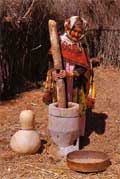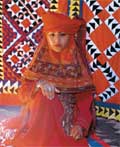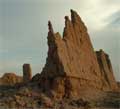Legends of ancient Karakalpakistan
The Great Silk Road passed through the Republic of Karakalpakistan. A large number of historical and archeological monuments and sites of ancient cities are located on its territory. Unfortunately, many of them are on the verge of disappearing. Places such as the sites Devkesken-Vasir, Mizdahkan and Gyaur-Qala will certainly greatly impress travelers.
The Devkensen-Vasir site of ancient cities is located on the Ustyurt plateau, bordering the Republic of Turkmenistan. It is known among the local population as Devkesken, which means "A fortress constructed by the Demon". The history of the city traces back to the 6-3rd cc. BC. The history of the study of Devkesken is rather short, and publications of corresponding material are not extremely numerous. The city, containing a citadel and a castle, is located at the end of the narrow gap of the Ustyurt. By layout it has the shape of an imperfect rectangle extending to the West. Three sides of the city walls have been preserved. The general area of the city is about 17 hectares.
Two mausoleums and a cathedral mosque are located within the city boundaries. The mosque on the plan is represented as a rectangle surrounded by stone walls with an arch and cupola gallery on columns inside. The Mihrab niche is oriented to Kiblah and arranged in a southern wall according to tradition. A hallway is also in the southern wall, closer to the western corner of the mosque.
Two mausoleums are located near the mosque. The history of their construction is connected with the legendary names of Farkhad and Shirin. The legend states that very long ago a powerful Edhem-shah ruled in the area of Daryalyk and Sarykamysh (ancient channels of the Amu-Darya river). He had a beautiful daughter named Shirin who was in love with the mason Farkhad, who also loved her passionately. Being against the marriage of the young people, but at the same time not wishing to offend his favorite daughter with a direct refusal, Edhem-shah declared that he would let her marry the person who could dig a ditch in the Ustyurt outcrop and build a fortress.
Though Farkhad was very skilled as a mason, such titanic work was beyond his power. However, Shirin was cunning enough to make thousands of her slaves work nights while Farkhad alone worked in the daytime. Some time had passed, and Edhem-shah got the report on the ditch and the fortress being finished. Being shocked and furious, the Shah declared that something was not right. Such colossal work couldn't have been completed by a human being but a Dev (i.e. malicious spirit).
Nevertheless, the promise given needed to be carried out. Still, not being eager to marry off Shirin to a commoner, the Shah himself ordered a thousand of his slaves to deepen the ditch in one place at night, and the next morning he said: "See, your Farkhad did not work today, and still Dev has done the job. He is a deceiver and you'll not marry him". Despairing, Farkhad died. This gave the name to the fortress "Strangled by Dev" - Devkesen. Soon after, Shirin also died. The two mausoleums, adjacently located in the southern part of the city above the rim of the Ustyurt plateau were built for them...
Another monument of the Mizdahkan site of ancient cities represents a huge complex of monuments of various periods. It's extremely difficult in topographical terms. Under the long influence of the weather, the complex has lost essentially its original distinctness, and definition of some of its parts has become possible only through micro relief which is problematic with ground methods of topographic work.
In 1966 Air photography of the whole Mizdahkan complex was completed. Based on the material of this activity, some objects were deciphered for the first time and the general plan of the complex was created. The whole complex of ruins is located on three small hills and on empty space between them. The ancient necropolis, located on one of these hills, was named "The Eastern Hill". A number of sites of archeological significance have been revealed on the northern side of the hill. Some of the archeological objects located on the territory of the necropolis have already been studied. Mazlumhan sulu mausoleum, Caliph Erezhep, Shamun Nadi and Djumat kassab are among them. Each of these objects has related folk legends, which are transferred from generation to generation.
The kind butcher
On the eastern hill of Mizdakhan, there is a height named Djumarat kassab, (Djumarat is the name, kassab is the butcher) which was probably used as dahma. Many legends are told among local population. One of them says that a mausoleum is hidden under the hill. A butcher, Djumarat by name, was buried there according to the legend. He was known for distributing meat to poor people in times of poor harvest and famine. For his kindness and compassion to the people he was deemed a holy person.
Legend of love
Once upon a time a beauty, named Mazlumhan, a daughter of the governor of the city, lived in Mizdahkan. Many rich and notable grooms were striving for her love, but she loved a poor young man. Mazlumhan was a princess, he was a builder, and there was no opportunity to connect their hearts. Mazlumhan rejected all the grooms, and the annoyed governor declared that he'd marry off his daughter to the one who would construct a minaret as high as the sky in one night. The poor young man in love built such a minaret and came for his beloved one to the palace in the morning. But the governor refused to give his daughter to the poor builder. Dejected, the young man jumped from the minaret. After him also jumped Mazlumhan-sulu. And only having died could they unite their souls. They were buried together. A mausoleum was erected over the grave. According to the legend, it was made of the bricks of the minaret destroyed on the governor's order.
There are various legends on Shamun Nabi. One of them declares: Shamun Nabi was one of the religious preachers in Khorezm before the adoption of Islam. The inhabitants of these places were not Muslims before his arrival. He appeared in these towns and concealed his real intentions. Yakhiya and Zakariya, the missionaries, arrived before him at these locations and started working openly, for which they were seized and thrown into zindan (prison).
Shamun Nabi took the position of a yard keeper, after which he was promoted to the treasurer of the state. Having discovered the jail where Yahin and Zakariya were imprisoned, he demanded they be released, stating that both of them were prophets and could be useful for sovereign Geura. The latter agreed to let them out, agreeing with that they were real prophets. To prove this, he suggested they revive the dead, and return sight to his blind daughter. The prophets executed this order and received freedom. From that time on, Shamun Nabi was considered sacred.
Another legend is told about the cult building of Caliph Erezhep. He taught his subjects for 40 years, and after his death his spirit continued the deeds of the sacred Caliph Erezhep. Once, two travelers argued over the sanctity of Caliph Erezhep. And when they came to his grave they heard a voice from it: "Return any borrowed money ". And since then people have believed in the sanctity of Caliph Erezhep.
The monument represents one of the finest architectural constructions built from both adobe and annealed bricks. On the base a reed layer was placed which protected the building from dampness and gave seismic stability to the walls. The building is dated to the beginning of the 9th c. AD.
These materials have been kindly provided by Dr. Oktyabr Dospanov.






